Abstract
Aleutian disease of mink is transferrable by cell-free extracts and is characterized by hepatitis, vasculitis, nephritis, and hypergammaglobulinaemia. Because of increasing evidence incriminating antigen—antibody complexes in vasculitis disorders, the presence of nuclear antigens and antinuclear antibodies in mink sera was investigated.
Serum pools as well as individual serum specimens were obtained from uninfected mink, mink with experimentally induced Aleutian disease, mink with spontaneous Aleutian Disease, all of genotype Aa as well as from `normal' mink of similar age from colonies without Aleutian disease.
The serum pool from mink before and after experimentally induced Aleutian disease appeared to contain `nuclear' antigens detectable by rabbit anti-DNA antibodies in complement fixation and precipitin tests. The protein-free extracts of these serum pools gave strong reactions for deoxypentose in the diphenylamine tests. These serum pools also were shown to contain antinuclear antibodies by the immunofluorescence tests on human leucocyte nuclei and in precipitin tests against single strand calf thymus DNA. Sera from individual mink were similarly shown to contain `nuclear' antigens and antinuclear antibodies. The incidence and quantity of antigens and antibody detected were much greater in sera from mink after experimentally induced disease than in sera taken from mink before inoculation. The presence of `nuclear' antigens and antinuclear antibodies did not correlate with the degree of hypergammaglobulinaemia. Sera from `normal' mink in colonies without overt disease had neither antigens nor antibodies detectable in precipitin tests. Sera from mink with spontaneously acquired Aleutian disease had a high incidence of `nuclear' antigens and anti-DNA antibodies detectable in precipitin tests.
The `nuclear' antigens were detectable in Ouchterlony precipitin tests by specific rabbit anti-DNA antibodies. The precipitins formed lines of partial identity with those between the rabbit anti-DNA antibodies and single strand calf thymus DNA. However, the antigens in mink sera were not destroyed by prior incubation with DNAse which had been the case with DNA antigens detected in some human and mouse sera.
The antinuclear antibodies were detected in immunofluorescence tests using specific antibodies to mink γ-globulins, were shown to fix complement with single strand calf thymus DNA, but not with DNA that had been digested with DNAse, and formed precipitins with single strand calf thymus DNA which showed complete identity with precipitins formed by rabbit anti-DNA antibodies. Evidence for the simultaneous presence of `nuclear' antigens with antinuclear antibodies in the serum from mink with Aleutian disease was frequently evident. This observation is consistent with the hypothesis for the pathogenetic role of antigen-antibody complexes.
Aleutian disease of mink has certain clinical pathological and serological similarities with disease in New Zealand Black mice and in man with systemic lupus erythematosus. Since Aleutian disease of mink and disease of New Zealand black mice may both be examples of `slow virus' infections, a similar aetiology should be considered for certain autoimmune diseases of man, e.g. systemic lupus erythematosus.
Full text
PDF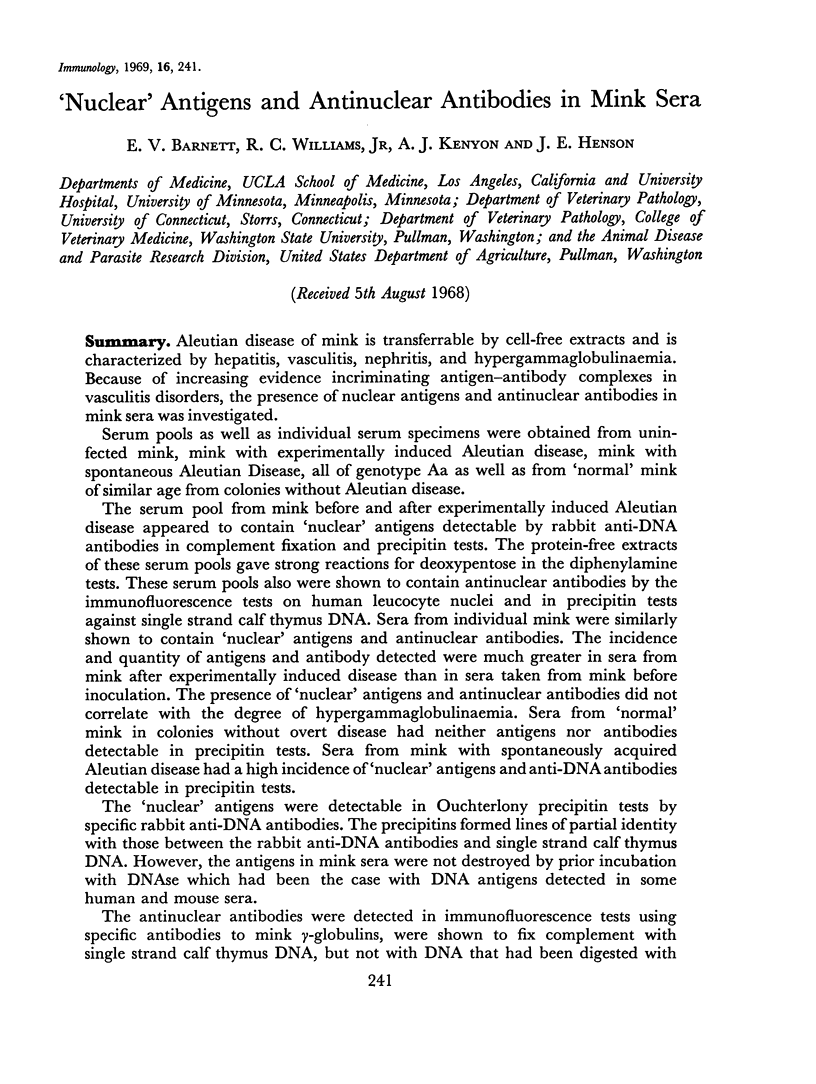
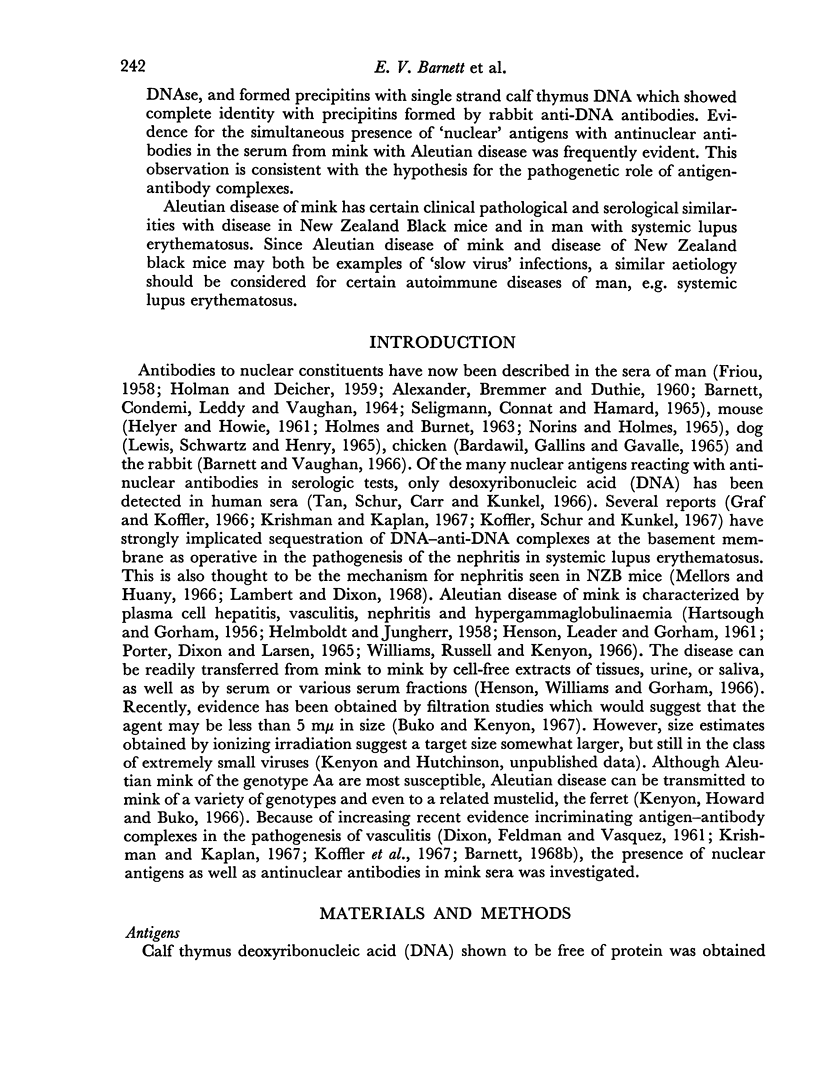
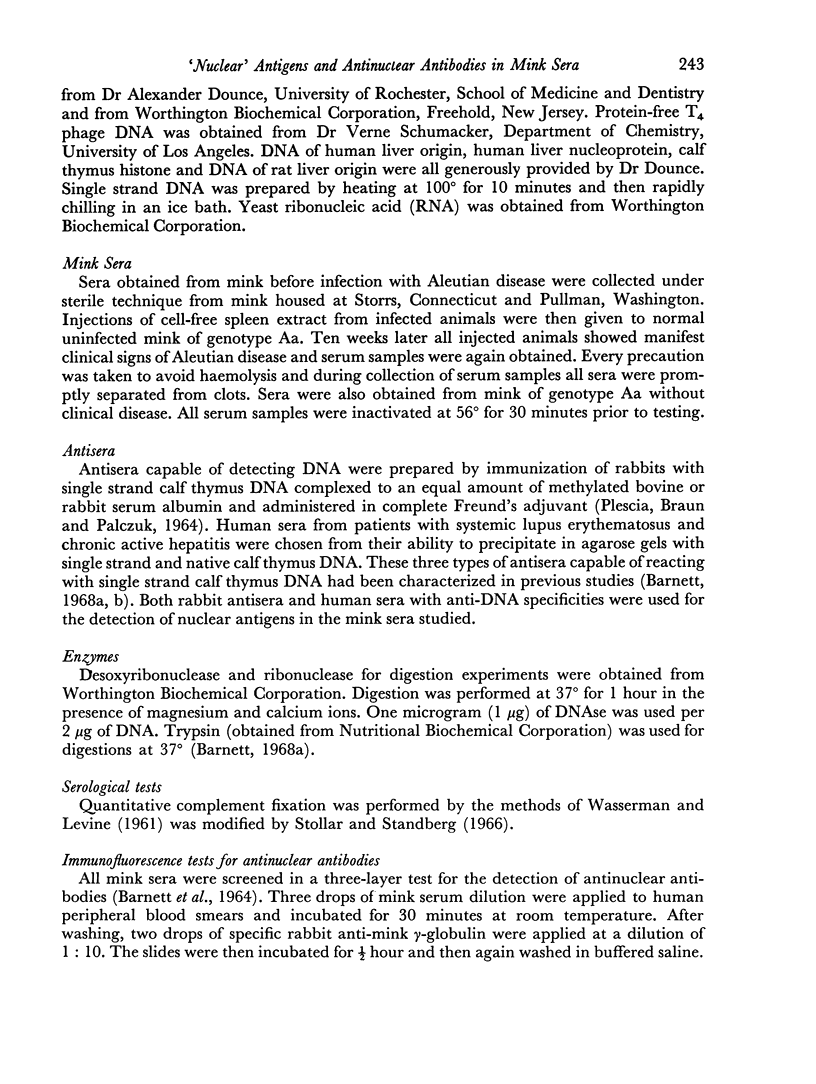
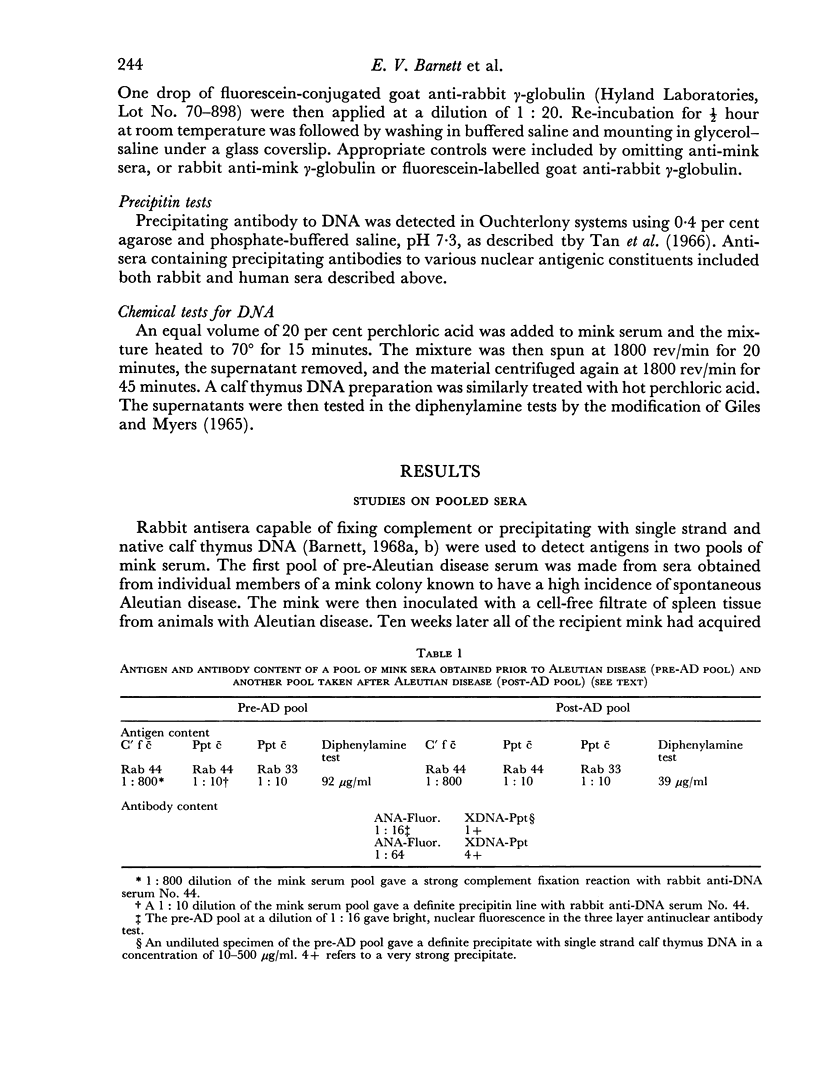
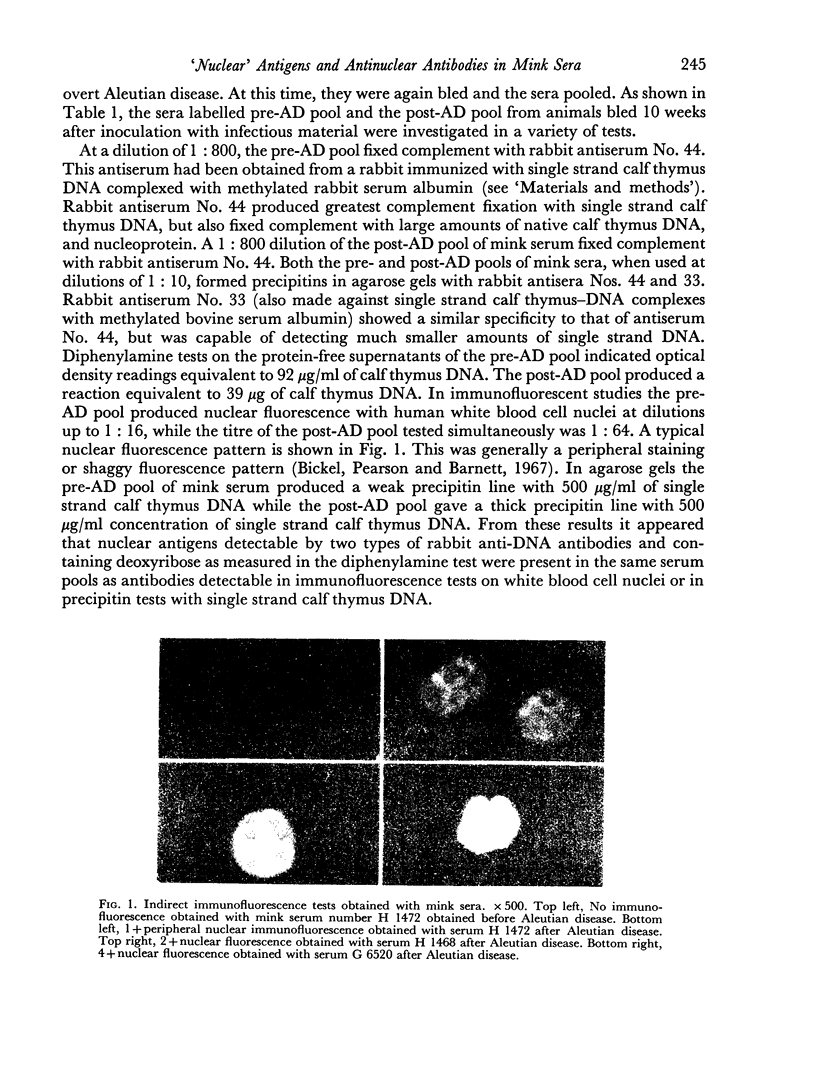
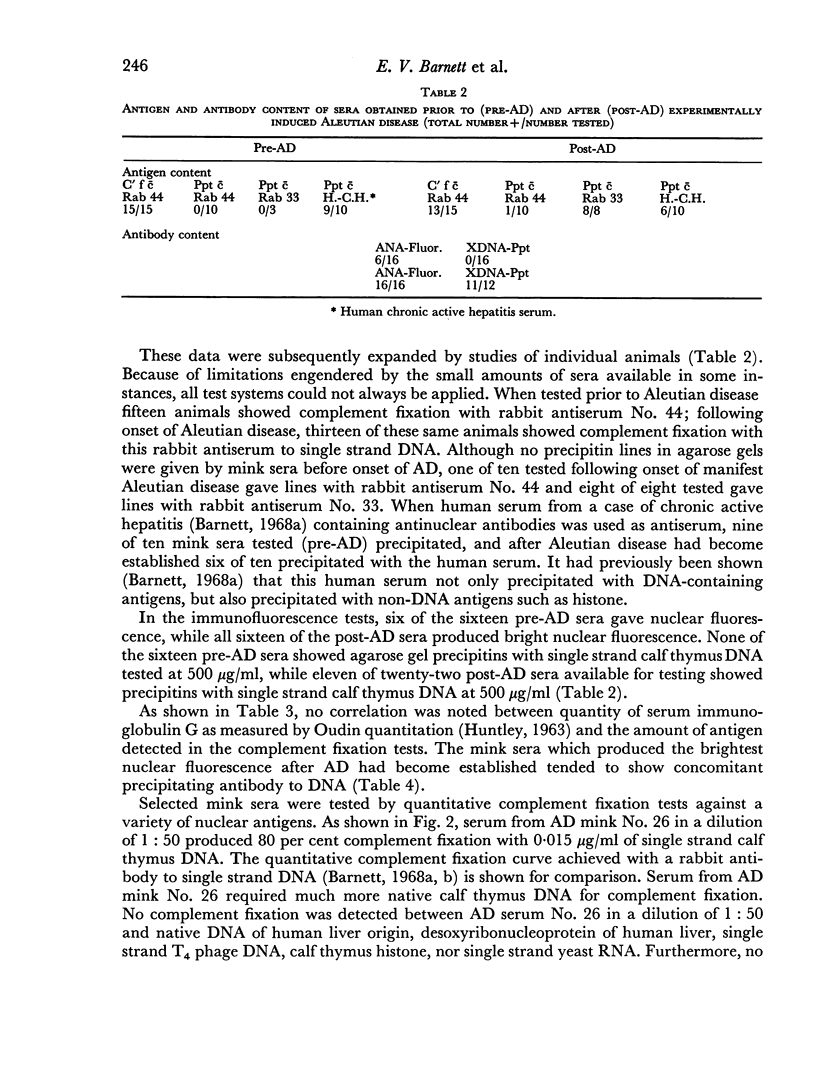
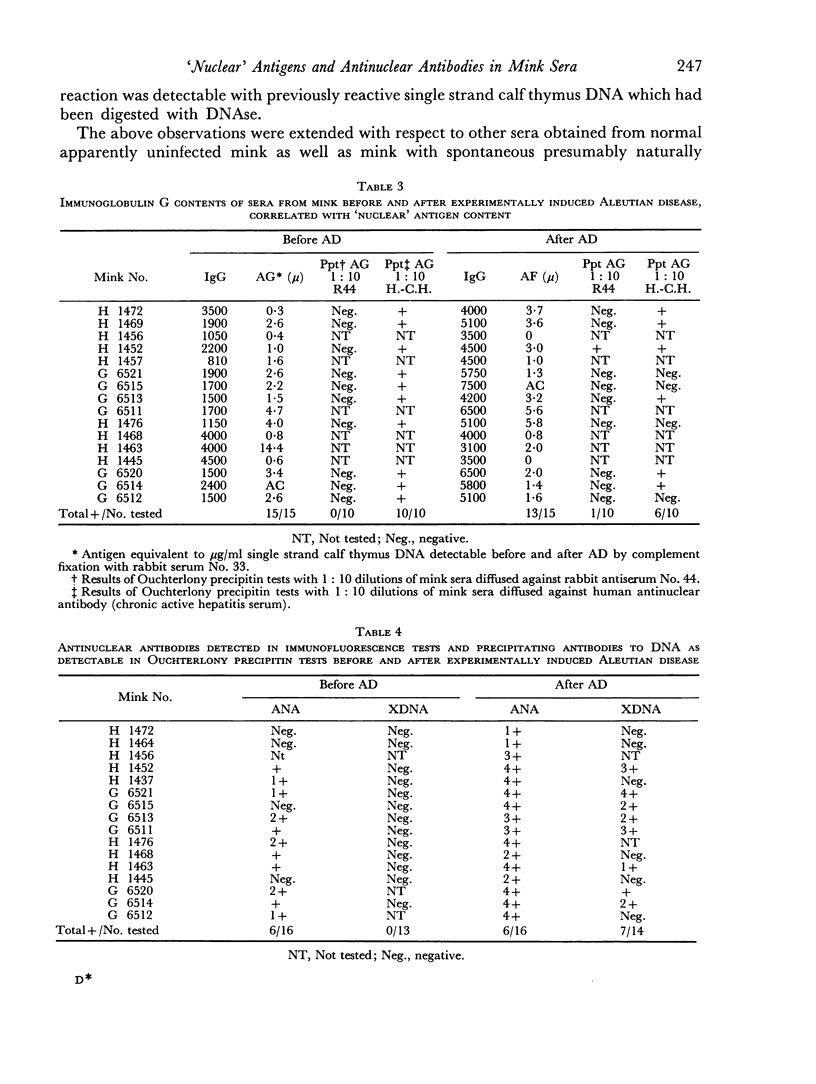
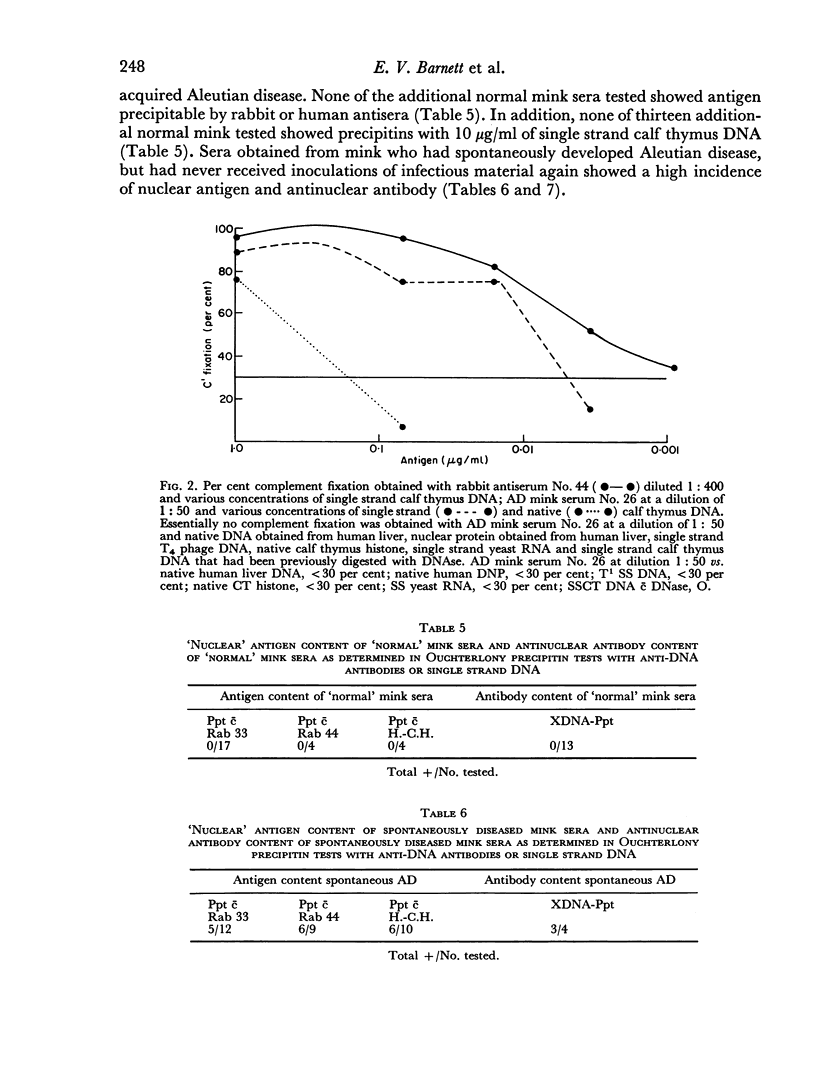
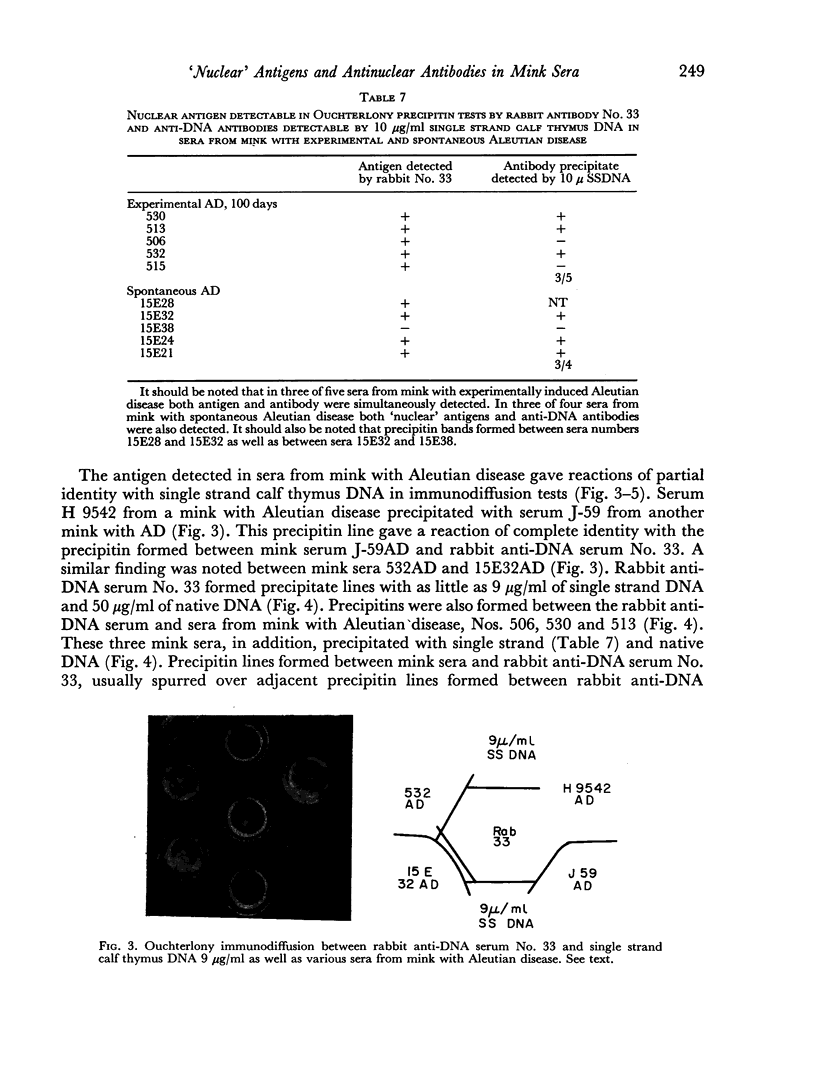
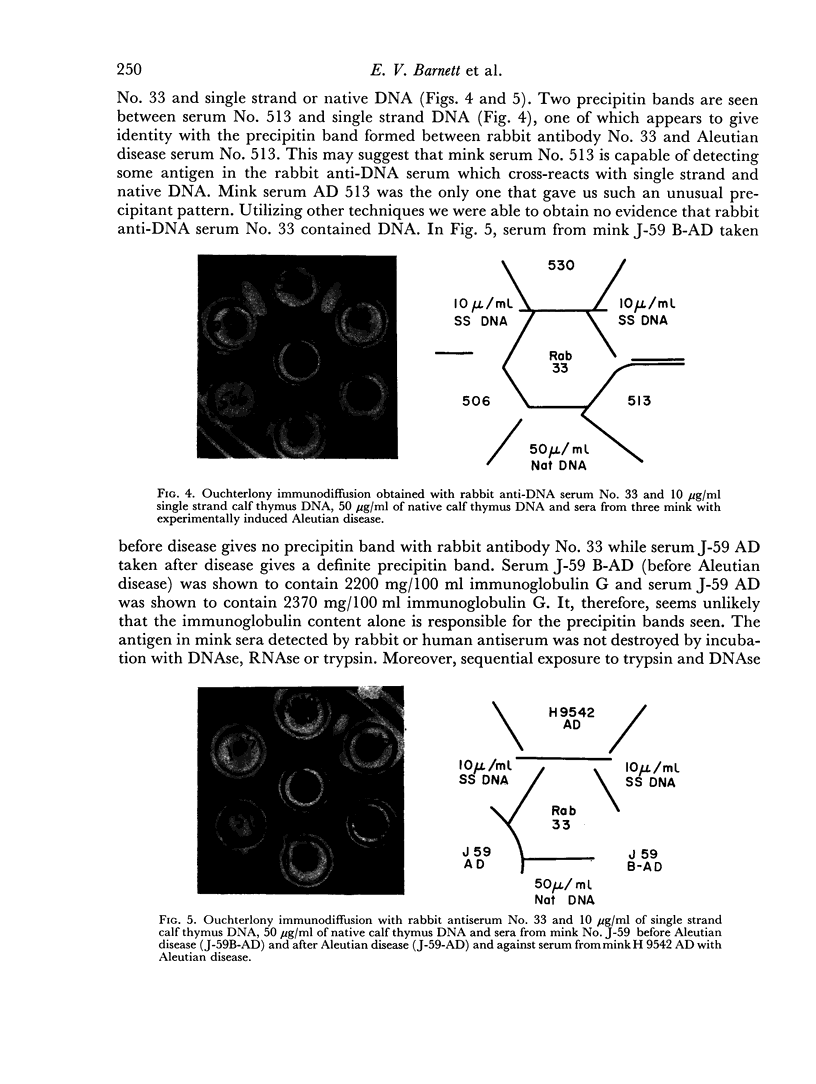
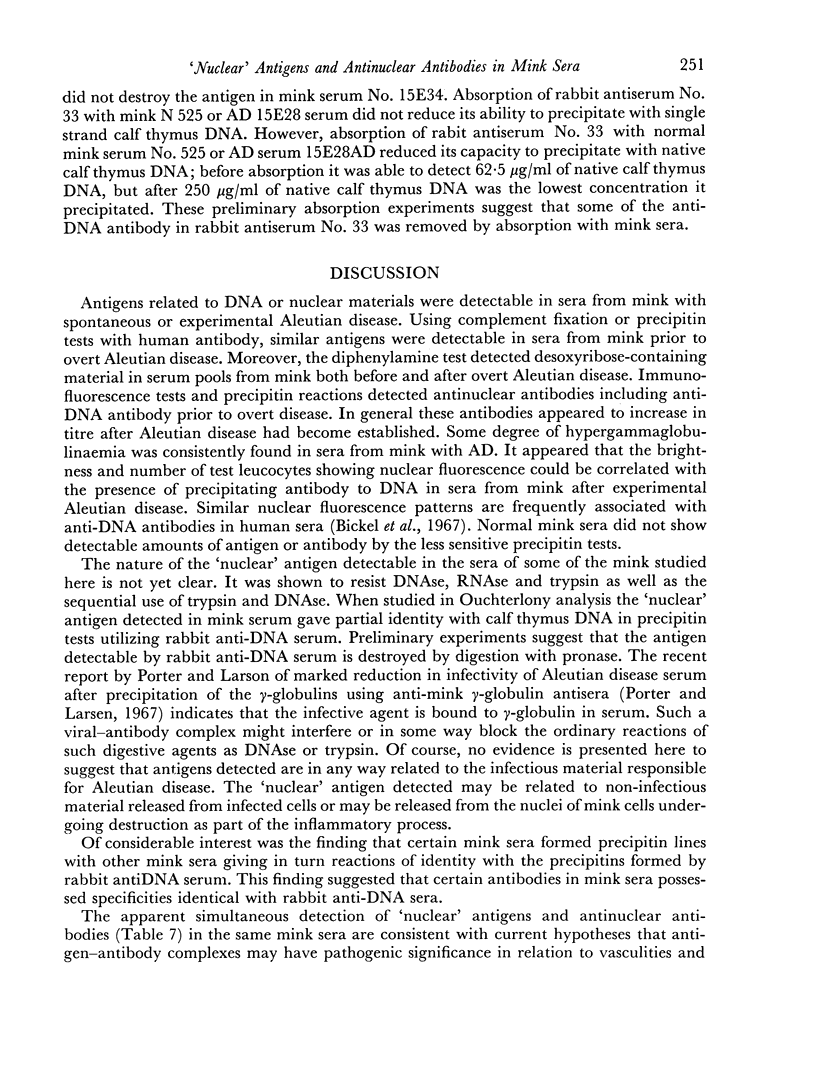
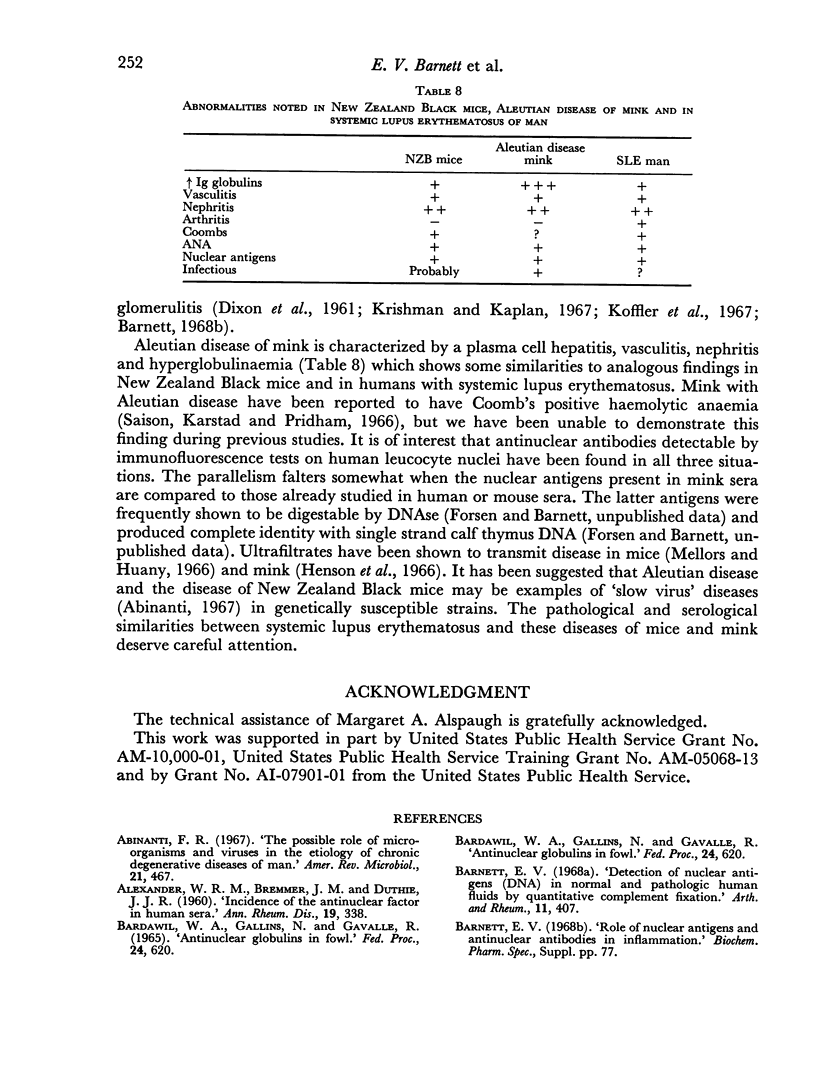
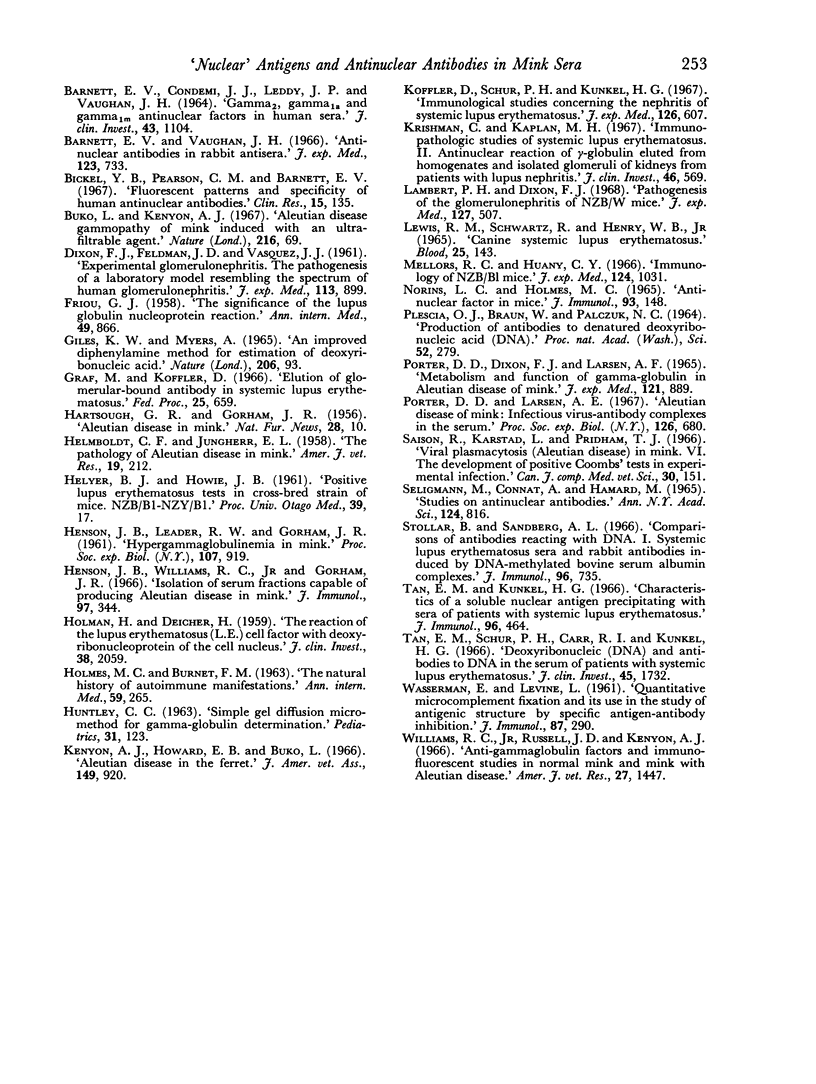
Images in this article
Selected References
These references are in PubMed. This may not be the complete list of references from this article.
- ALEXANDER W. R., BREMNER J. M., DUTHIE J. J. Incidence of the anti-nuclear factor in human sera. Ann Rheum Dis. 1960 Dec;19:338–350. doi: 10.1136/ard.19.4.338. [DOI] [PMC free article] [PubMed] [Google Scholar]
- Abinanti F. R. The possible role of microorganisms and viruses in the etiology of chronic degenerative diseases of man. Annu Rev Microbiol. 1967;21:467–494. doi: 10.1146/annurev.mi.21.100167.002343. [DOI] [PubMed] [Google Scholar]
- BARNETT E. V., CONDEMI J. J., LEDDY J. P., VAUGHAN J. H. GAMMA-2, GAMMA-1A AND GAMMA-1M ANTINUCLEAR FACTORS IN HUMAN SERA. J Clin Invest. 1964 Jun;43:1104–1115. doi: 10.1172/JCI104995. [DOI] [PMC free article] [PubMed] [Google Scholar]
- Barnett E. V. Detection of nuclear antigens (DNA) in normal and pathologic human fluids by quantitative complement fixation. Arthritis Rheum. 1968 Jun;11(3):407–417. doi: 10.1002/art.1780110306. [DOI] [PubMed] [Google Scholar]
- Barnett E. V., Vaughan J. H. Antinuclear antibodies in rabbit antisera. J Exp Med. 1966 Apr 1;123(4):733–746. doi: 10.1084/jem.123.4.733. [DOI] [PMC free article] [PubMed] [Google Scholar]
- Buko L., Kenyon A. J. Aleutian disease gammopathy of mink induced with an ultra-filtrable agent. Nature. 1967 Oct 7;216(5110):69–70. doi: 10.1038/216069a0. [DOI] [PubMed] [Google Scholar]
- FRIOU G. J. The significance of the lupus globulin; nucleoprotein reaction. Ann Intern Med. 1958 Oct;49(4):866–875. doi: 10.7326/0003-4819-49-4-866. [DOI] [PubMed] [Google Scholar]
- HELMBOLDT C. F., JUNGHERR E. L. The pathology of Aleutian disease in mink. Am J Vet Res. 1958 Jan;19(70):212–222. [PubMed] [Google Scholar]
- HENSON J. B., LEADER R. W., GORHAM J. R. Hypergammaglobulinemia in mink. Proc Soc Exp Biol Med. 1961 Aug-Sep;107:919–920. doi: 10.3181/00379727-107-26795. [DOI] [PubMed] [Google Scholar]
- HOLMAN H., DEICHER H. R. The reaction of the lupus erythematosus (L.E.) cell factor with deoxyribonucleoprotein of the cell nucleus. J Clin Invest. 1959 Nov;38:2059–2072. doi: 10.1172/JCI103984. [DOI] [PMC free article] [PubMed] [Google Scholar]
- HOLMES M. C., BURNET F. M. THE NATURAL HISTORY OF AUTOIMMUNE DISEASE IN NZB MICE. A COMPARISON WITH THE PATTERN OF HUMAN AUTOIMMUNE MANIFESTATIONS. Ann Intern Med. 1963 Sep;59:265–276. doi: 10.7326/0003-4819-59-3-265. [DOI] [PubMed] [Google Scholar]
- HUNTLEY C. C. Simple gel diffusion micromethod for gamma-globulin determination. Pediatrics. 1963 Jan;31:123–129. [PubMed] [Google Scholar]
- Henson J. B., Williams R. C., Jr, Gorham J. R. Isolation of serum fractions capable of producing Aleutian disease in mink. J Immunol. 1966 Sep;97(3):344–349. [PubMed] [Google Scholar]
- Koffler D., Schur P. H., Kunkel H. G. Immunological studies concerning the nephritis of systemic lupus erythematosus. J Exp Med. 1967 Oct 1;126(4):607–624. doi: 10.1084/jem.126.4.607. [DOI] [PMC free article] [PubMed] [Google Scholar]
- Krishnan C., Kaplan M. H. Immunopathologic studies of systemic lupus erythematosus. II. Antinuclear reaction of gamma-globulin eluted from homogenates and isolated glomeruli of kidneys from patients with lupus nephritis. J Clin Invest. 1967 Apr;46(4):569–579. doi: 10.1172/JCI105558. [DOI] [PMC free article] [PubMed] [Google Scholar]
- LEWIS R. M., SCHWARTZ R., HENRY W. B., Jr CANINE SYSTEMIC LUPUS ERYTHEMATOSUS. Blood. 1965 Feb;25:143–160. [PubMed] [Google Scholar]
- Lambert P. H., Dixon F. J. Pathogenesis of the glomerulonephritis of NZB/W mice. J Exp Med. 1968 Mar 1;127(3):507–522. doi: 10.1084/jem.127.3.507. [DOI] [PMC free article] [PubMed] [Google Scholar]
- MASTER R. W. POSSIBLE SYNTHESIS OF POLYRIBONUCLEOTIDES OF KNOWN BASE-TRIPLET SEQUENCES. Nature. 1965 Apr 3;206:93–93. doi: 10.1038/206093b0. [DOI] [PubMed] [Google Scholar]
- Mellors R. C., Huang C. Y. Immunopathology of NZB/BL mice. V. Viruslike (filtrable) agent separable from lymphoma cells and identifiable by electron microscopy. J Exp Med. 1966 Dec 1;124(6):1031–1038. doi: 10.1084/jem.124.6.1031. [DOI] [PMC free article] [PubMed] [Google Scholar]
- NORINS L. C., HOLMES M. C. ANTINUCLEAR FACTOR IN MICE. J Immunol. 1964 Jul;93:148–154. [PubMed] [Google Scholar]
- PLESCIA O. J., BRAUN W., PALCZUK N. C. PRODUCTION OF ANTIBODIES TO DENATURED DEOXYRIBONUCLEIC ACID (DNA). Proc Natl Acad Sci U S A. 1964 Aug;52:279–285. doi: 10.1073/pnas.52.2.279. [DOI] [PMC free article] [PubMed] [Google Scholar]
- PORTER D. D., DIXON F. J., LARSEN A. E. METABOLISM AND FUNCTION OF GAMMA GLOBULIN IN ALEUTIAN DISEASE OF MINK. J Exp Med. 1965 Jun 1;121:889–900. doi: 10.1084/jem.121.6.889. [DOI] [PMC free article] [PubMed] [Google Scholar]
- Saison R., Karstad L., Pridham T. J. Viral plasmacytosis (Aleutian disease) in mink. VI. The development of positive Coombs test in experimental infections. Can J Comp Med Vet Sci. 1966 Jun;30(6):151–156. [PMC free article] [PubMed] [Google Scholar]
- Seligmann M., Cannat A., Hamard M. Studies on antinuclear antibodies. Ann N Y Acad Sci. 1965 Jun 30;124(2):816–832. doi: 10.1111/j.1749-6632.1965.tb19004.x. [DOI] [PubMed] [Google Scholar]
- Tan E. M., Kunkel H. G. Characteristics of a soluble nuclear antigen precipitating with sera of patients with systemic lupus erythematosus. J Immunol. 1966 Mar;96(3):464–471. [PubMed] [Google Scholar]
- Tan E. M., Schur P. H., Carr R. I., Kunkel H. G. Deoxybonucleic acid (DNA) and antibodies to DNA in the serum of patients with systemic lupus erythematosus. J Clin Invest. 1966 Nov;45(11):1732–1740. doi: 10.1172/JCI105479. [DOI] [PMC free article] [PubMed] [Google Scholar]
- WASSERMAN E., LEVINE L. Quantitative micro-complement fixation and its use in the study of antigenic structure by specific antigen-antibody inhibition. J Immunol. 1961 Sep;87:290–295. [PubMed] [Google Scholar]






